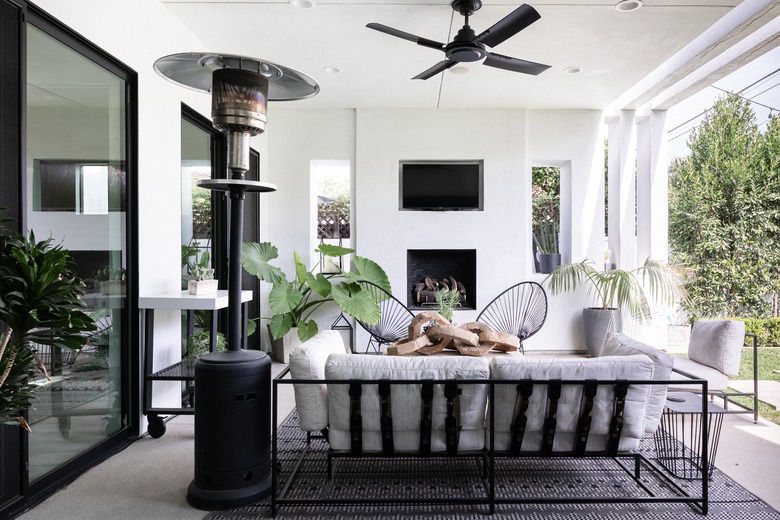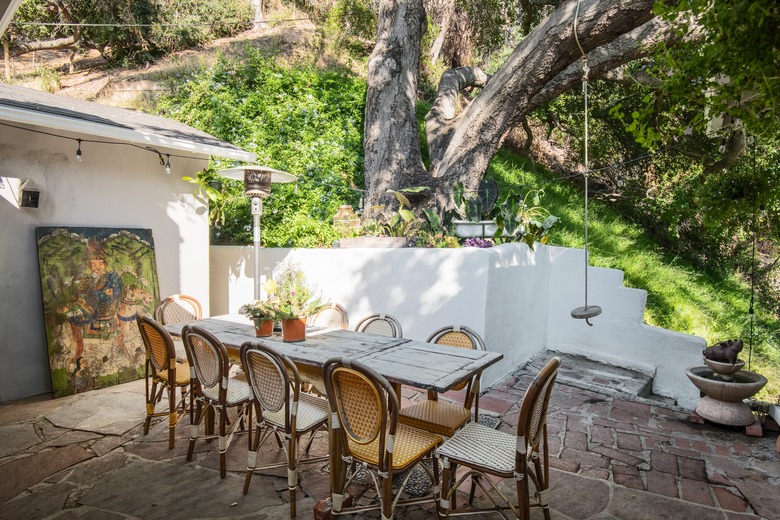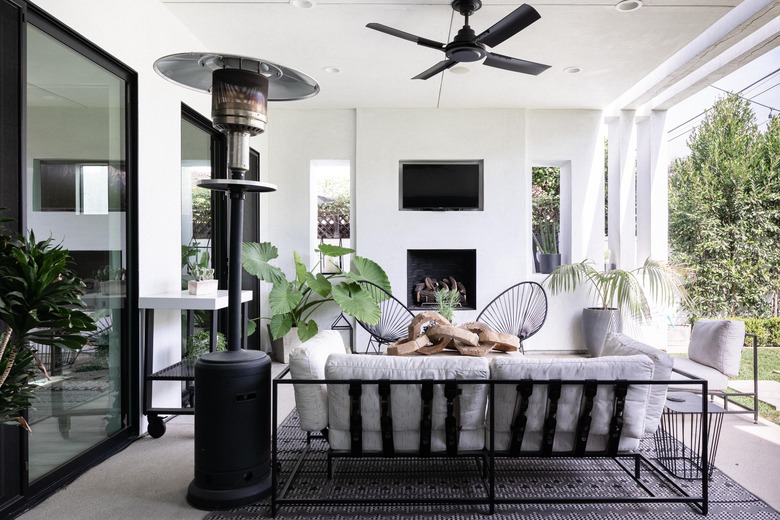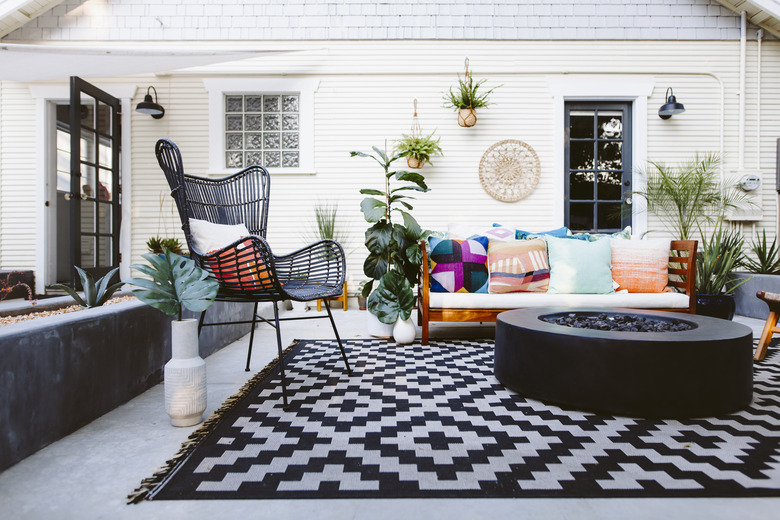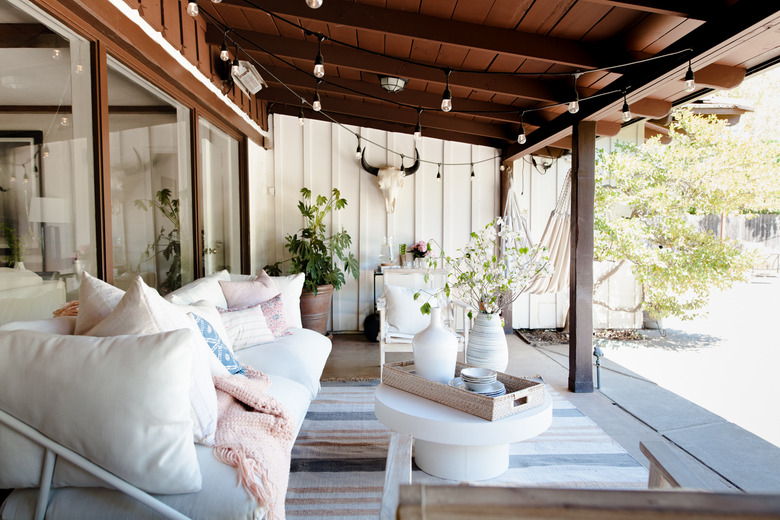Picking The Best Material For Outdoor Furniture: How-To Guide
We hate to be the bearers of bad news, but there's more to your outdoor furniture than picking out pretty patterns. Whether you're basking in the sunshine year-round or embracing all four seasons, it's important to select weather-resistant furniture (that means dining tables, poolside loungers, and even umbrellas) that can handle whatever Mother Nature throws your way.
So what makes a dining set or accessory outdoor-friendly? The right materials. Not only should you invest in high-quality pieces that are durable enough to withstand both extreme temperatures and torrential downpours, but it's also in your best interest to focus on low-maintenance fabrics that won't fade over time.
Before you add anything to your cart, check out our tips for choosing durable patio furniture. We cover the materials you should look for and how the climate weighs in. Our comprehensive guide covers all the bases.
The Best Wood for Outdoor Furniture
The Best Wood for Outdoor Furniture
Just because wood comes from the great outdoors doesn't necessarily mean every single type is ideal for your outdoor area. When it comes to finding the best wood furniture, it's important to keep strength and durability in mind.
Acacia
Acacia wood, for example, is a great option if you're looking for something that is hardy and affordable. Plus, thanks to the high oil content, it can repel the elements, water rot, and even insects. Just make sure you treat acacia with a sealant. Otherwise, it can fade in the sun, warp, or crack.
Black Locust
Live in a super cold or hot climate? Well, furniture made of black locust wood boasts flavonoids that combat various weather conditions such as high winds, heat, and cold. It's also resistant to fungus and bugs such as termites and ants. However, the tight grains can make black locust pieces tricky to stain.
Teak
Teak wood is considered to be one of the best outdoor furniture materials, and for good reason. This species features natural oils that repel water — which help prevent warping and cracking — as well as insects. Not only is it virtually weatherproof, but it's also incredibly beautiful. However, teak furniture tends to be quite pricey.
Ipe
Known for having a warm and rich-toned grain, ipe wood also has a high oil content that makes it excellent for outdoor furniture. It resists decomposition and various forms of fungi and is dense enough to avoid dents and warping. But ipe can be incredibly difficult to cut and prep, so some furniture manufacturers choose not to use it.
Shorea
Both heavier and more durable than teak, shorea is another great option for outdoor furniture. It has a naturally high oil content that prevents insect infestations and water damage. Plus, it can typically last more than 50 years. Shorea furniture is less well-known, though. So it tends to be harder to find at most retailers.
Eucalyptus
If you want rustic-looking outdoor furniture that won't break the bank, eucalyptus is the way to go. This wood grows quickly and lasts an incredibly long time, to boot. The natural oils work as an insect deterrent. However, if it's not treated with a sealant, eucalyptus furniture is prone to cracking.
Oak
Although oak wood doesn't have much natural oil, this material is still a good choice for outdoor furniture. Its structural formation repels water and rot (which is why it's long been used for boats). And if left untreated, white oak forms a lovely gray patina.
The Weather Factor: When it comes to wooden outdoor furniture, you can never go wrong with teak wood. As long as you treat it with a sealant, teak is a suitable option for hot and sunny climates, mild regions, and chilly outdoor spaces.
The Best Metal for Outdoor Furniture
The Best Metal for Outdoor Furniture
We love the sleek, modern look of metal outdoor furniture, but the maintenance and upkeep can be extensive. You have to take into consideration rain and water damage, for example, because rusted furniture doesn't look good in any setting. Plus, certain metal pieces can get really hot after a long, sunny day. Here's more on what you should look out for.
Steel
When it comes to choosing metal outdoor furniture, both galvanized and stainless steel are popular materials. Overall, steel is durable and quite heavy, which means high winds won't blow it around. It's super easy to clean with mild soap and water. And the composition is naturally resistant to rust. However, both kinds of steel are often quite expensive, and they retain heat.
Aluminum
Aluminum frame metal furniture, on the other hand, is less susceptible to heat retention. So you won't burn yourself if you want to enjoy some outdoor dining on a summer day. However, this material is very light so it can easily blow over in a windy climate.
Iron
We can't forget wrought iron furniture either. This material has been used for centuries to compose tools, buildings, and more because it's so durable. It's also heavy enough to endure strong wind storms. However, iron furniture has its fair share of cons. It tends to get incredibly cold in the winter and scorching hot in the summer. Plus, even when sealed, iron can be prone to rust.
The Weather Factor: Weather can play a huge role in your metal outdoor furniture selection. Steel is a sound choice for mild climates, and treated aluminum is suitable for cold, mild, and coastal regions. You'll have plenty of options between wood and metal, but don't write off plastic outdoor furniture just yet. Resin and high-density plastic are popular in coastal regions, while PVC is a must for hot, dry climates.
The Best Fabric for Outdoor Furniture
The Best Fabric for Outdoor Furniture
Don't be fooled by the fabric on outdoor patio furniture. Though these textiles might look and sometimes feel the same, they are very different. Generally speaking, there are three common types of outdoor fabric: acrylic, olefin, and polyester.
Acrylic
Acrylic is arguably the most popular outdoor furniture fabric around. Not only is this material super soft, but it's also known to dry quickly, stay cool in the beaming sun, and keep mildew at bay. Plus, the fade- and water-resistant fabric Sunbrella — which is featured on everything from throw pillows to cushions to umbrellas — falls under the acrylic category. After all, the Sunbrella brand's upholstery fabrics can reportedly block as much as 75% of the sun's heat and reduce a space's temperature by a few degrees. Since Sunbrella materials are often regarded as premium outdoor furniture fabrics, use these textiles for outdoor space staples like a couch, rug, or umbrella.
Olefin
While acrylic fabrics are regarded as some of the best outdoor textiles around, they can get a little pricey. For a cost-effective alternative, give olefin a try.
All things considered, olefin is a suitable alternative to acrylic fabric. While some sources argue it's not as game-changing as Sunbrella, it's not as expensive, either. This material has other perks, too. In addition to being water-, fade-, and UV-resistant, olefin reportedly doesn't transmit static charge. If you don't want to splurge on a fancier fabric like Sunbrella, olefin can be a great option for outdoor cushions.
Polyester
Looking for outdoor patio furniture on a budget? Opt for polyester, which is known for being incredibly affordable. While polyester fabric is one of the cheaper options on the market, the quality can vary based on the thickness. If you go with a super thin iteration, expect sunspots. But just because polyester furniture has its flaws doesn't mean you should overlook it. If you don't want to break the bank, you can reduce potential damage by coating your fabric with a sun protectant or storing your cushions and umbrellas inside when not in use.
The Weather Factor: Does your home's average climate determine the best type of fabric for your outdoor furniture? Not particularly. Since Sunbrella is both fade- and water-resistant, it's a great choice for all regions.
The Best Filling for Outdoor Patio Furniture
The Best Filling for Outdoor Patio Furniture
Of course, the fabric you use for your chaises, couches, and throw pillows is only one piece of the puzzle. It's just as important to choose a filling that will make it easy to kick back, relax, and, you know, enjoy your outdoor furniture.
Polyester Foam
If you're looking for filling that's equal parts comfortable and supportive, consider opting for polyester foam. It air dries quickly, is non-allergenic, and doesn't break down over time. It will, however, eventually compress, so your cushions won't be as plush as they were when you first purchased them.
Polyurethane Foam
Polyurethane foam is often used for the filling on pillows, so it's usually treated with chemicals to keep fungus at bay. The use of chemicals shouldn't deter you, but you might want to wrap your foam in plastic before slipping it into the pillowcase. That way, you can be comfortable and give yourself some peace of mind.
The Weather Factor: No matter what type of foam you purchase, it's important to choose between open- and closed-cell foam. Open-cell foam has pores that let air and water easily pass through. Accordingly, it's a great option for wet climates. If you live in a warm, dry climate, give closed-cell foam a try. Not only is this option often used on boats, making it perfect for any and all outdoor activities, but it also doesn't absorb water, so you won't have to worry about your cushions slumping and sagging after extended periods of use.
Now that you know the basics, are you ready to shop?
Here's our comprehensive list of the best places to shop for outdoor patio furniture.
